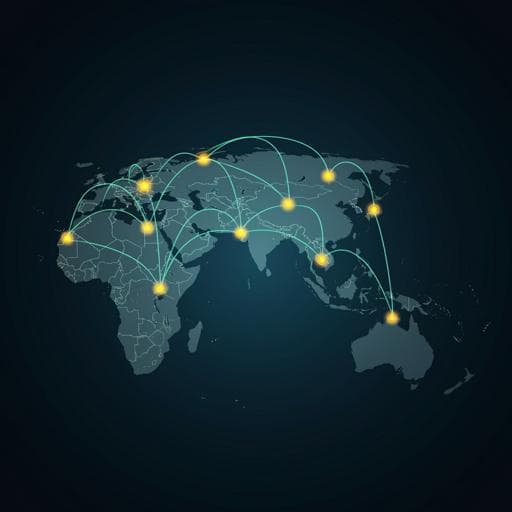
Economics
Substitution effect of Asian economies on China's industrial and supply chains: from the perspective of global production network
L. Xing, S. Jiang, et al.
This research conducted by Lizhi Xing, Shuo Jiang, Simeng Yin, and Fangke Liu delves into how the Altasia region could disrupt China's industrial dominance. By employing a multi-regional input-output model, the findings reveal that enhanced trade within Altasia may accelerate the relocation of China's supply chains, especially in sectors reliant on resources and labor, while highlighting China's ongoing strengths in capital-intensive industries.
~3 min • Beginner • English
Introduction
The paper investigates whether and how a hypothesized regional bloc—Altasia (ASEAN except Myanmar plus Japan, South Korea, India, Bangladesh)—can substitute for China within global industrial and supply chains. Against a backdrop of geopolitical tension, friend-shoring, and the restructuring of global value chains, the study asks to what extent strengthening intra-Altasia integration could trigger decoupling and relocation risks for the China Production Network (CPN). It motivates the question by contrasting China’s entrenched manufacturing hub status and high-tech strengths with rising cost advantages and demographic dividends in Altasia, and by noting the United States’ policy push to de-risk supply chains away from China. The objective is to quantify the potential exposure of China’s industrial linkages to relocation when Altasia or ASEAN act as tightly integrated production entities, using a network perspective built on MRIO data.
Literature Review
The review situates Altasia’s substitution effect as a contemporary form of international industrial transfer driven by changing comparative advantages and U.S. friend-shoring policies. Classical theories (flying geese, core-periphery, product life cycle, labor-intensive transfer, new economic geography) primarily address globalization-era transfers, whereas current trends show regionalization and bloc formation. MRIO-based value-added accounting has advanced measurement of interregional industrial transfer, though empirical work is limited by database lags. Friend-shoring research remains largely theoretical but suggests shifts of capacity to allied regions. Network science offers tools to capture complex multi-country sectoral interactions; the Global Production Network (GPN) and related network accounting frameworks can identify topology, hierarchy, and dynamics of trade in intermediates. The Local-World Evolving Network model explains regionalized preferential attachment consistent with trade agreements (RCEP, CPTPP, IPEF). Overall, prior work underscores the need for network-based, MRIO-grounded analysis to disentangle Altasia’s potential substitution effect on China beyond trade-flow snapshots.
Methodology
Data: The study uses the intermediate use block of the ADB-MRIO 2023 update (E62), covering 62 explicitly identified economies plus Rest of World, 35 industrial sectors, for years 2007 and 2007–2022 (annual), at current and 2010 constant prices, with at least 93% of world GDP coverage. Sector and country codes are aligned with ADB MRIO (Tables 2 and 3). Each year’s network initially has 2,205 sector-economy nodes (62 economies × 35 sectors plus RoW).
Network construction: Industrial sectors are nodes; inter-industry intermediate flows are directed weighted edges. This yields a dense Global Industrial Value Chain Network (GIVCN). To visualize and analyze salient structure, the X-Index Filtering Algorithm (XIFA) extracts the Global Industrial Value Chain Backbone Network (GIVCBN), pruning weak ties at ego-network level without parameters.
Model scenarios:
- Null model (GIVCBN-I): Build GIVCN from ADB MRIO, prune with XIFA, then merge Altasia economies into a loosely integrated representation for presentation (resulting dichotomized network ~1,750 nodes).
- Counterfactual Altasia (GIVCBN-II): First merge Altasia’s internal sectors into a tightly integrated entity within GIVCN to elevate intra-Altasia competition for intermediates, then prune with XIFA and dichotomize.
- Counterfactual ASEAN (GIVCBN-III): First merge nine ASEAN members’ sectors (excluding Myanmar) into a tightly integrated entity, prune with XIFA, then merge ASEAN with the remaining Altasia-relevant economies for comparison. These counterfactuals simulate reduced internal trade frictions inside Altasia/ASEAN, allowing them to displace less efficient chains elsewhere.
Network-level indicators: Average Path Length (APL) to gauge separation/chain length; Average Clustering Coefficient to gauge local interconnection/clustering; Asymmetry (root-mean-square in- vs out-degree difference) to gauge vertical specialization.
Node-level indicators: In-/Out-Degree Centrality (influence scope as demander/supplier of intermediates); Betweenness Centrality (hub/profitability, control over value flows); In-/Out-Closeness Centrality (robustness/centrality with respect to upstream/downstream uncertainties). Indicators are computed per model-year and compared as ratios (counterfactual/null) to quantify impacts. Chord diagrams compare link deletions between models to identify decoupling risk pairs.
Validation: Non-random model construction (structured merging then pruning) ensures topology heterogeneity reflects economic assumptions, enabling meaningful comparison of null vs counterfactual networks over 2007–2022.
Key Findings
- Magnitude of substitution and decoupling: Treating Altasia as a tight bloc breaks roughly 25 of China’s industrial and supply chain linkages, while treating ASEAN alone breaks fewer than 15, indicating stronger substitution when Japan, South Korea, India, and Bangladesh are included due to complementarities.
- Network-level impacts:
- Average Path Length ratios (counterfactual/null) exceed 1 across years, implying longer, less efficient chains and greater separation when Altasia/ASEAN integrate; the effect is stronger for Altasia. APL has rebounded since 2018, consistent with China’s adjustments (e.g., RCEP-driven capacity rebalancing, overseas layouts).
- Average Clustering Coefficient ratios are below 1, showing weakened local interconnection within CPN and partial decoupling; impacts are larger under Altasia than ASEAN.
- Asymmetry ratios are above 1, indicating reduced vertical specialization/cohesion; in 2020 the Altasia-to-null ASY ratio exceeded 1.4, reflecting COVID-19 disruptions, strict “Zero COVID” containment in China, and accelerated diversification toward Altasia.
- Node-level impacts on China:
- Degree centrality: Altasia reduces China’s in/out-degree centrality particularly in resource- and labor-intensive sectors (e.g., Agriculture S01, Wood S06, Real Estate S29), while capital- and technology-intensive sectors (e.g., Chemicals S09, Electrical and Optical Equipment S14) are less affected.
- Betweenness centrality: Most representative Chinese sectors show decreased betweenness under Altasia, with the strongest loss in resource-intensive sectors (notably S01). Under ASEAN-only integration, many sectors’ betweenness ratios exceed 1, implying China’s hub/profitability can improve when ASEAN integrates without East/South Asian tech leaders. For S14, Altasia does not diminish and may enhance its hub function.
- Closeness centrality: In-/Out-closeness ratios are close to 1, indicating China’s overall robustness and central status in GPN remain largely intact despite localized relocations.
- Sectoral patterns:
- Resource-intensive (S01, S02, S03): Strongest substitution by Altasia; China’s supplier role in S01 is notably replaced.
- Labor-intensive (S04): Noticeable substitution, consistent with cost-driven relocations to Southeast/South Asia.
- Capital-/technology-intensive (e.g., S09/S12/S14): Limited direct substitution; China retains advantages, especially in higher value segments and as a supplier of high-value intermediates.
- Contextual statistics: Southeast Asia attracted record $222.5 billion FDI in 2022; 2018–2022 U.S. capital investment projects in SEA totaled $74.3 billion, and China invested $68.5 billion, highlighting Altasia’s role as a broker for global supply chain diversification.
- Trade pattern adjustments: Evidence of Chinese value added embedded in third-country exports to the U.S. (e.g., Vietnam laptop assembly drawing on Chinese components), indicating China’s continued upstream role even as final assembly relocates.
Discussion
The analysis demonstrates that tighter intra-Altasia integration would materially increase decoupling risks for China’s resource- and labor-intensive chains, lengthen and fragment China’s production networks, and reduce local clustering within the CPN. Yet, China’s capital- and technology-intensive sectors largely sustain their positions, and overall network robustness (closeness) remains stable, reflecting China’s deep global connections and comprehensive industrial base. These results address the research question by quantifying how Altasia’s formation affects CPN topology at macro and micro levels, clarifying that Altasia’s substitution effect is significant but concentrated in lower value segments. They also contextualize COVID-19 and policy-driven friend-shoring as catalysts accelerating diversification. Strategically, deepening RCEP-led cooperation, targeted overseas investment, and upgrading into higher value-added nodes can mitigate adverse effects while leveraging ASEAN as a complementary partner when East/South Asian tech leaders are not jointly integrated.
Conclusion
The paper contributes a network-based counterfactual framework (GIVCBN-I/II/III) using recent ADB-MRIO data to quantify substitution risks to China’s industrial and supply chains from Altasia/ASEAN integration. It shows Altasia would cause more extensive link breakages (~25 vs <15 for ASEAN), raise path lengths, lower clustering, and increase asymmetry, with the most impact on resource-/labor-intensive sectors. China retains advantages and resilience in capital-/technology-intensive segments, and its central role in GPN remains. Policy recommendations: (1) Deepen trade/investment ties with key near/offshoring destinations (e.g., Vietnam, Thailand, Mexico), support Chinese firms’ overseas investments, and keep upgrading domestic high-tech, high–value-added manufacturing to supply higher-value intermediates. (2) For high-risk resource-intensive sectors, prevent excessive offshoring to avoid hollowing-out, while promoting import substitution and strategic emerging industries (new energy, materials, advanced manufacturing, electronic information; plan for frontier fields like brain-like intelligence, quantum, deep-sea/space, hydrogen, energy storage); improve IP protection and market access to retain MNCs. (3) Build resilient regional/domestic value chains via Belt and Road and RCEP, pursue CPTPP accession, and enhance China’s role in GVC rule-making and governance. Future research should refine MRIO frameworks to distinguish domestic vs foreign-owned activity (e.g., OECD-AMNE MRMIMO) to better capture multinational-led capacity shifts and their impact on GPN resilience.
Limitations
- Data timeliness and attribution: MRIO databases exhibit lag, and disentangling COVID-19, geopolitical, and policy effects is challenging.
- Territorial accounting bias: Standard MRIO treats foreign affiliates’ value added like domestic firms’, obscuring ownership effects; this can misstate the impact of multinational capacity transfers.
- Counterfactual assumptions: Altasia is hypothetical; merging economies into tightly integrated blocs abstracts from real-world frictions (policy, logistics, institutions).
- Network pruning and merging choices: Results depend on XIFA backbone extraction and the order of merging vs pruning (as illustrated), which can alter retained links.
- Sectoral aggregation: 35-sector classification may mask intra-sector heterogeneity and firm-level dynamics.
- Visualization constraints: Chord diagrams and network plots are interpretive summaries; quantitative link-loss counts depend on backbone thresholds.
Related Publications
Explore these studies to deepen your understanding of the subject.







